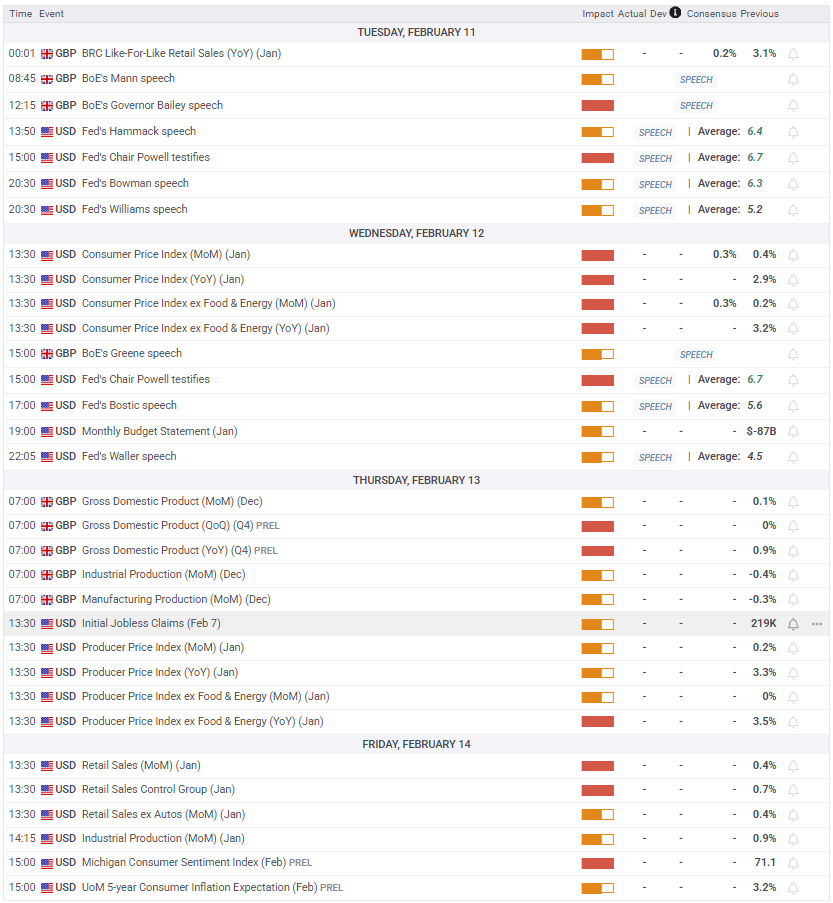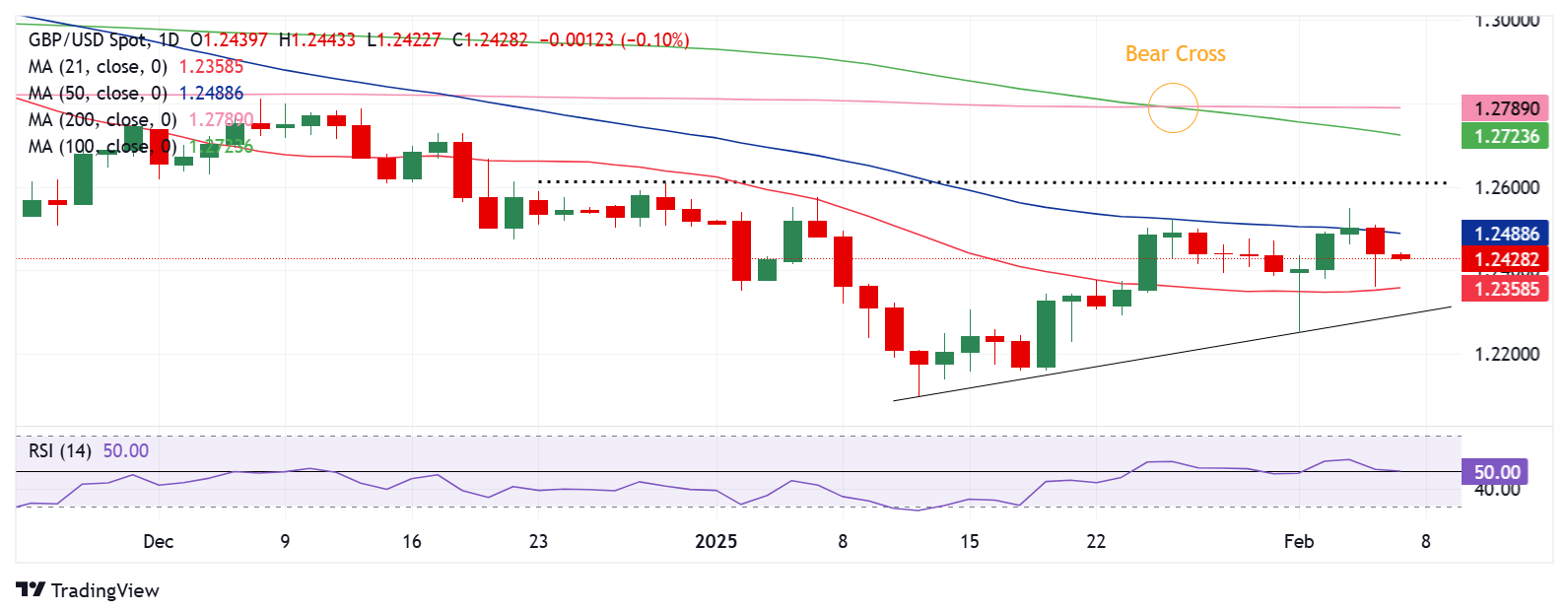- The Pound Sterling failed to sustain its recovery against the US Dollar in the BoE’s rate-decision week.
- GBP/USD looks to US inflation and UK growth data for the next directional move.
- Pound Sterling eyes a range breakout on the daily time frame amid a neutral RSI.
The Pound Sterling (GBP) failed to sustain its recovery against the US Dollar (USD), reviving the selling interest around the GBP/USD pair.
Pound Sterling pounded by dovish BoE cut
It was all about US President Donald Trump’s tariff war with Canada, Mexico and China at the start of the week, with attention returning to the fundamentals in the second half. That said, GBP/USD witnessed intense volatility during the week but remained confined within a 150 pips range.
In the early part of the week, risk sentiment took a hit and rebounded firmly on US President Donald Trump’s tariff play.
Trump on Saturday imposed 25% tariffs on Canada and Mexico while imposing a 10% levy on China, effective 05:01 GMT on Tuesday. Markets resorted to ‘sell everything’ mode on Monday, flocking to the go-to haven, the USD, at the expense of the risk sensitive Pound Sterling.
However, the tide turned against the Greenback in Monday’s American trading after the US struck a deal with Mexico and Canada to delay tariffs by a month in exchange for strict border security from both its neighbors and to ban fentanyl exports to the US.
The US Dollar extended its downtrend alongside the prolonged correction in the US Treasury bond yields as risk sentiment continued to recover. The USD bore the brunt of receding fears of a potential global trade war amid Trump’s pushback on Canada and Mexico for a month while markets look past the US-Sino tariff war, expecting no further escalation.
Sustained USD weakness helped the Pound Sterling build on its recovery momentum, driving GBP/USD to test the 1.2550 level – its highest point in a month. The turnaround, however, was short-lived as Pound Sterling sellers returned on a dovish interest rate cut decision announced by the Bank of England (BoE) on Thursday.
The BoE lowered the key policy rate by the expected 25 basis points (bps) to 4.5% and slashed its forecasts for economic growth this year after months of stagnation. Markets perceived the decision as dovish after ultra-hawk Catherine Mann unexpectedly became one of two rate-setters to lean in favor of a half-point reduction.
BoE Governor Andrew Bailey said in his post-policy meeting press conference, “We expect to be able to cut bank rate further but we will have to judge meeting by meeting how far and how fast.”
The UK central bank left the door ajar for further rate cuts. Meanwhile, markets expect that the Fed could backtrack on its projections of two rate reductions this year under Trump’s presidency. The trade and foreign policies of the 47th US President are seen as inflationary.
Increased expectations of the divergent trend in the BoE and the Fed policy outlooks, remain a drag on the Pound Sterling despite the ongoing US Dollar decline. On the final trading day of the week, GBP/USD managed to hold its ground following the mixed labor market data from the US. In January, Nonfarm Payrolls (NFP) rose by 143,000, missing the market expectation of 170,000. On a positive note, the Unemployment Rate edged lower to 4% from 4.1% and December’s NFP increase of 256,000 got revised higher to 307,000.
Week ahead: US inflation and UK GDP in focus
Pound Sterling traders await the UK fourth-quarter preliminary Gross Domestic Product (GDP) data after the BoE’s latest easing.
However, in the early part of the week, China’s inflation report-led impact on risk sentiment will drive markets. Further, any developments surrounding US President Donald Trump’s foreign policies will also provide fresh impetus to GBP/USD traders starting a relatively light week data-wise.
Other than the UK growth and industrial figures, due on Thursday, only Wednesday’s US Consumer Price Index (CPI) data holds relevance in the upcoming week.
Friday will feature the US Retail Sales data, which will wrap up a less eventful week.
Traders will keep an eye on Trump’s plans and speeches from Fed policymakers during the week.
GBP/USD: Technical Outlook
The daily chart shows that GBP/USD is set to extend its rangebound play, with the upside capped by the 50-day Simple Moving Average (SMA) at 1.2489. On the other hand, the pair continues to find buyers at the 21-day SMA at 1.2385.
The 14-day Relative Strength Index (RSI) has turned neutral, currently at 50, suggesting a lack of a clear directional bias.
The Pound Sterling must yield a daily candlestick closing above the 50-day SMA at 1.2489 to resume the recovery toward the December 30 high of 1.2608.
The next relevant upside target is aligned at the 1.2650 psychological level, above which a fresh uptrend could initiate toward the 100-day SMA at 1.2724.
With a 100-day SMA and 200-day SMA Bear Cross in play, the downside risks remain intact for GBP/USD.
If the retracement gains traction below the 21-day SMA at 1.2385, sellers could challenge the rising trendline support at 1.2292.
If they manage to find a strong foothold below that level, a fresh downtrend toward the January 20 low of 1.2160 will be in the offing.








